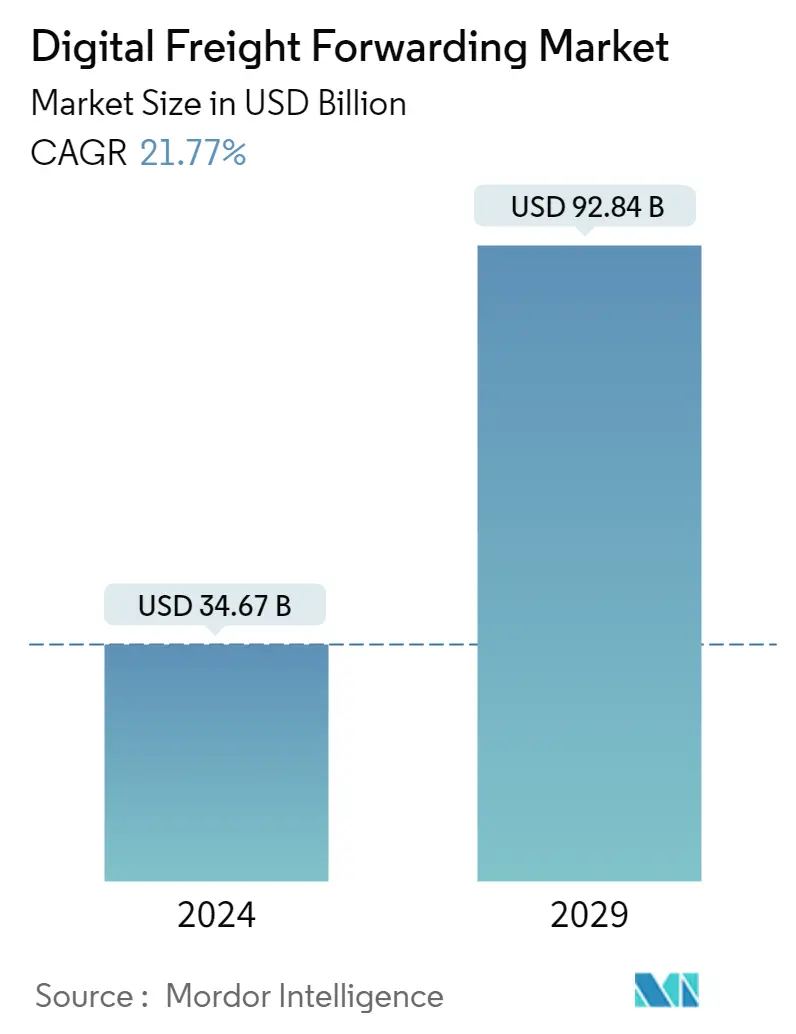Market Size of Digital Freight Forwarding Industry

| Study Period | 2020 - 2029 |
| Base Year For Estimation | 2023 |
| Market Size (2024) | USD 34.67 Billion |
| Market Size (2029) | USD 92.84 Billion |
| CAGR (2024 - 2029) | 21.77 % |
| Market Concentration | Low |
Major Players
*Disclaimer: Major Players sorted in no particular order |
Digital Freight Forwarding Market Analysis
The Digital Freight Forwarding Market size is estimated at USD 34.67 billion in 2024, and is expected to reach USD 92.84 billion by 2029, growing at a CAGR of 21.77% during the forecast period (2024-2029).
Digitization is continuing to be one of the key drivers supporting growth of the current economy. Companies like convoy, Uber Freight and uShip are coming up with new platforms to fill in the gaps in the logistics industry. With Digital freight forwarding the manual process will be reduced. All the quotations for freight forwarding will be available at one platform without the hassle of hours of conversation and paper trails. The major benefits of digital freight forwarding include instant quotes, transparent pricing, comparison of rates and carriers, tracking, easy documentation and others. The logistics industry is developing to a paperless digitized industry supporting the growth of the market.
Digital Freight Forwarding Industry Segmentation
Digital Freight Forwarding Market report provides insights on the market like Market Overview, Market Dynamics, Value Chain / Supply Chain Analysis, Investment Scenarios, Government Regulations and Initiatives, Technology Development in Online Freight Forwarding and Digital Platforms, Overview on E-commerce Logistics and Freight Forwarding, Value Propositions of E-platforms Vs Competitors and Industry Attractiveness - Porter's Five Forces Analysis. The report also covers impact of Covid-19 on the market.
Furthermore, the report also provides company profiles with leading market players to understand the competitive landscape of the market.
| By Mode of Transport | |
| Land | |
| Sea | |
| Air |
| By Geography | |||||||||||
| |||||||||||
| |||||||||||
| |||||||||||
| |||||||||||
|
Digital Freight Forwarding Market Size Summary
The digital freight forwarding market is experiencing significant growth, driven by the ongoing digitization of the logistics industry. Companies such as Convoy, Uber Freight, and uShip are pioneering new platforms that streamline the freight forwarding process, reducing the need for manual interventions and extensive paperwork. This shift towards digital solutions offers numerous advantages, including instant quotes, transparent pricing, and efficient tracking and documentation. As the logistics sector evolves into a more digitized and paperless industry, the market for digital freight forwarding is poised for substantial expansion. The rise of e-commerce, particularly in developing markets like China, India, and Indonesia, further fuels this growth, as manufacturers increasingly adopt digital freight solutions to meet the demands of both domestic and cross-border trade.
The competitive landscape of the digital freight forwarding market is characterized by a high degree of fragmentation, with numerous players offering a variety of logistics services through digital platforms. Companies like Flexport, which has established itself as a leader in the market, leverage advanced analytics and high-quality logistics services to enhance their value proposition. The market includes a diverse range of participants, such as Twill, FreightHub, and Agility Logistics, all of which contribute to the dynamic and rapidly evolving nature of the industry. These digital freight forwarders focus on providing a seamless user experience by aggregating information and services on a single platform, thereby simplifying the shipping process and improving overall efficiency.
Digital Freight Forwarding Market Size - Table of Contents
-
1. MARKET INSIGHTS
-
1.1 Current Market Scenario
-
1.2 Value Chain / Supply Chain Analysis
-
1.3 Investment Scenarios
-
1.4 Government Regulations and Initiatives
-
1.5 Technology Development in Online Freight Forwarding and Digital Platforms
-
1.6 Overview on E-commerce Logistics and Freight Forwarding
-
1.7 Value Propositions of E-platforms Vs Competitors
-
1.8 Impact of Covid-19 on the Market
-
-
2. MARKET SEGMENTATION
-
2.1 By Mode of Transport
-
2.1.1 Land
-
2.1.2 Sea
-
2.1.3 Air
-
-
2.2 By Geography
-
2.2.1 North America
-
2.2.1.1 United States
-
2.2.1.2 Canada
-
2.2.1.3 Mexico
-
-
2.2.2 Europe
-
2.2.2.1 Germany
-
2.2.2.2 France
-
2.2.2.3 Netherlands
-
2.2.2.4 United Kingdom
-
2.2.2.5 Italy
-
2.2.2.6 Rest of Europe
-
-
2.2.3 Asia-Pacific
-
2.2.3.1 China
-
2.2.3.2 Japan
-
2.2.3.3 Australia
-
2.2.3.4 India
-
2.2.3.5 Singapore
-
2.2.3.6 Malaysia
-
2.2.3.7 Indonesia
-
2.2.3.8 South Korea
-
2.2.3.9 Rest of Asia-Pacific
-
-
2.2.4 Middle East & Africa
-
2.2.4.1 South Africa
-
2.2.4.2 Egypt
-
2.2.4.3 GCC Countries
-
2.2.4.4 Rest of Middle East & Africa
-
-
2.2.5 South America
-
2.2.5.1 Brazil
-
2.2.5.2 Chile
-
2.2.5.3 Rest of South America
-
-
-
Digital Freight Forwarding Market Size FAQs
How big is the Digital Freight Forwarding Market?
The Digital Freight Forwarding Market size is expected to reach USD 34.67 billion in 2024 and grow at a CAGR of 21.77% to reach USD 92.84 billion by 2029.
What is the current Digital Freight Forwarding Market size?
In 2024, the Digital Freight Forwarding Market size is expected to reach USD 34.67 billion.

